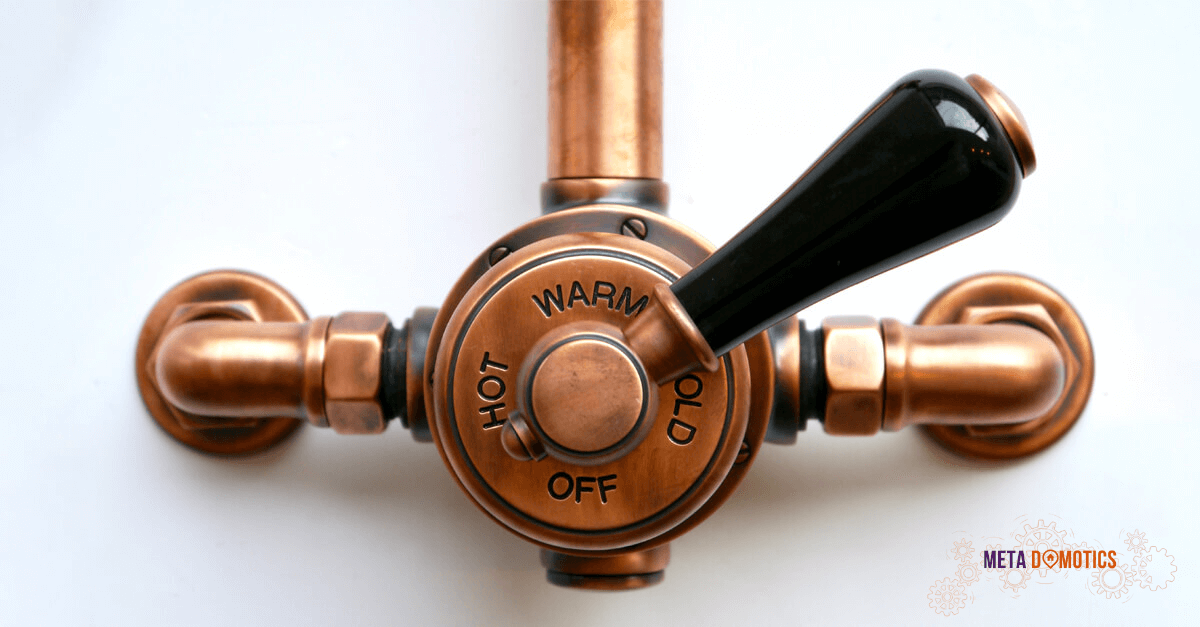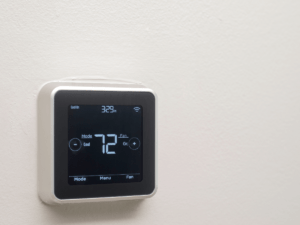You’re probably wondering how does a thermostatic shower valve works? Well.. here’s how it works.
A thermostatic shower valve is a crucial component of any shower system, responsible for regulating the temperature and flow of water in your shower.
It works by measuring the temperature of the water before it reaches your showerhead and then adjusting the flow of hot and cold water as necessary to maintain a consistent temperature.
A thermostatic shower valve has 4 main elements:
- The temperature control handle: This is used to adjust the temperature of the water coming out of the shower.
- The mixing valve: This mixes hot and cold water to get the desired temperature for your shower.
- Pressure balance valve: This helps keep a consistent flow of water even if someone else in your house turns on another faucet or toilet, so you don’t get a sudden burst of hot or cold water.
- Anti-scald safety device: This helps keep you safe by automatically shutting off if it senses that the temperature is too high.
The valve also helps to prevent scalding by quickly shutting off the flow of hot water if the temperature gets too high. This makes it an ideal choice for families with small children or elderly relatives who are more sensitive to sudden changes in water temperature.
The valve is typically located behind the shower wall, and is easily accessible for maintenance and repair. The valve works using a thermostatic cartridge, which contains a temperature-sensitive wax that expands or contracts in response to changes in the water temperature.
This movement is then translated into adjustments in the flow of hot and cold water, ensuring that the shower water stays at a safe and comfortable temperature.
One of the key benefits of a thermostatic shower valve is that it provides precise temperature control. This allows you to set your shower to a specific temperature and have it remain consistent, even if there are fluctuations in the water pressure or temperature from the hot water heater.
Furthermore, the valve is designed to provide rapid response time, meaning that it can quickly respond to changes in the water temperature, ensuring that the water remains at a safe and comfortable temperature at all times.
Overall, a thermostatic shower valve is an essential component of any modern shower system, offering precise temperature control, rapid response time, and a high level of safety.
What are the Benefits of a Thermostatic Shower Valve?
A thermostatic shower valve offers several advantages over traditional shower valves. Some of these advantages include:
- Consistent temperature control:
The thermostatic shower valve’s ability to precisely control temperature is a key advantage. This means that regardless of changes in the hot water heater’s temperature or water pressure, you can set your shower to a specific temperature and have it stay there.
- Safety:
The valve is made to have a quick response time, which enables it to react quickly to changes in water temperature, ensuring that the water is always kept at a safe and comfortable temperature.
The valve also has safety features like automatic shut off if the temperature rises above a certain point, which adds another layer of defense against hot water burns.
- Easy installation:
Thermostatic shower valves are typically easy to install and do not require any special plumbing skills. This makes them an ideal choice for do-it-yourselfers and homeowners who are looking to upgrade their shower system.
- Ease of use:
The valve is typically located behind the shower wall and is easily accessible for maintenance and repair. It operates using a simple and intuitive mechanism, making it easy to use for people of all ages and skill levels.
- Energy efficiency:
A thermostatic shower valve can help reduce water waste by controlling the flow of water, ensuring that only the necessary amount of water is used.
Furthermore, by maintaining a consistent temperature, the valve can help reduce energy waste by preventing the hot water heater from having to continually heat water to make up for fluctuations in the water temperature.
In summary, a thermostatic shower valve has a number of benefits over conventional shower valves, including reliable temperature control, safety features, usability, simplicity of installation, and energy efficiency.

What are the Cons of a Thermostatic Shower Valve?
Although thermostatic shower valves have many advantages, you should be aware of a few drawbacks as well. They are as follows:
- Cost:
Thermostatic shower valves are typically more expensive than traditional shower valves, and can be a significant investment for some homeowners.
- Complexity:
A thermostatic shower valve’s internal dynamics are more complicated than those of a standard shower valve, which can make repairs and maintenance more challenging.
- Maintenance:
For the valve to continue to function properly, it needs to be cleaned and its thermostatic cartridge replaced on a regular basis.
- Limited compatibility:
Some thermostatic shower valves are designed for specific plumbing configurations, which can limit their compatibility with certain shower systems.
- Calibration:
To make sure the valve is accurately controlling temperature, it might need to be calibrated on a regular basis.
- Technical issues:
In rare cases, the valve may develop technical issues, such as leaks or faulty temperature sensing, which can result in the need for repair or replacement.
- Sensitivity to water quality:
The valve may be sensitive to water quality issues, such as mineral buildup, which can affect its ability to accurately control the water temperature.
Overall, while thermostatic shower valves offer many benefits, it is important to consider the potential disadvantages before making a purchase. This will help ensure that you choose a valve that meets your needs and is a good investment for your home.
Frequently Asked Questions – How Does A Thermostatic Shower Valve Works?
Why do thermostatic shower valves fail?
There are several reasons why thermostatic shower valves can fail:
- Calcium buildup:
Over time, hard water deposits can build up inside the valve, clogging the internal components and affecting the accuracy of the temperature control.
- Worn out components:
The internal components of a thermostatic shower valve, such as the valve cartridge, can wear out over time due to repeated use and exposure to high water temperatures.
- Lack of maintenance:
If a thermostatic shower valve is not regularly cleaned and maintained, it can become clogged with mineral buildup, causing the valve to fail.
- Poor installation:
If the thermostatic shower valve is not installed correctly, it can cause leaks and result in the valve failing to work properly.
- Manufacturing defects:
In some cases, thermostatic shower valves may fail due to manufacturing defects, such as a faulty valve cartridge or a defective temperature control mechanism.
How long does the thermostatic shower valve last?
The lifespan of a thermostatic shower valve can vary depending on several factors, including the quality of the valve, the frequency of use, and the level of maintenance.
Typically, a well-made, high-quality thermostatic shower valve can last for about 4-5 years or more with proper care and maintenance. However, if the valve is exposed to hard water, high water temperatures, or other environmental factors, it may fail sooner.
It’s important to regularly clean and maintain your thermostatic shower valve to ensure it lasts as long as possible. This can include cleaning the valve of any mineral buildup, replacing worn out components, and tightening loose fittings to prevent leaks.







